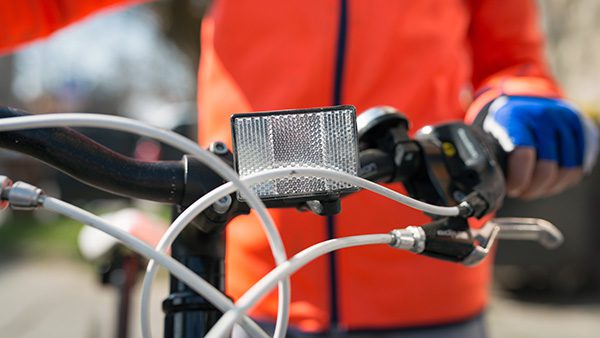Enjoy the bicycle boom: 5 tips for safe riding

Make yourself visible no matter the time of day. Reflectors help, but flashing lights are even better.
I put more miles on my bike than my car in 2021. Sticking to a few rules of the road kept me safe and accident-free, and I’d like to share them with you:
1. Be seen, but ride like you can’t be – Adding lights to your bike makes it more visible, day or night. Strobing lights are better than reflectors. You can even add lights to your clothing, with high-visibility clothing working wonders at dawn, dusk and when the sun is bright. Despite the effort of being seen, ride as if you’re wearing Harry Potter’s invisibility cloak.
Drivers naturally look for vehicles that occupy a full lane rather than thin vehicles occupying about a third of the lane, as that’s what they experience most of the time. To protect yourself:
Avoid stopping directly next to vehicles with large profiles; they likely can’t see you in their mirrors – a potential problem if they’re turning.
Look all directions through intersections before crossing, even if you have a green light.
Continually scan for obstacles with your hands over the brakes. Defensive driving applies to riding bikes, too.
2. Be prepared with the essentials – You wouldn’t drive a car without airbags or seatbelts. Nor should you hop on a bike without essential safety gear:
Helmets protect your head should you fall or get thrown from your bike.
Sunglasses or clear safety glasses can shield you from dust, debris, wind and even rocks kicked up by cars or trucks.
Gloves add protection if you fall. Our natural reaction to falling is to stick out a hand to brace ourselves, but having a road-rashed hand for weeks could make daily tasks challenging.
Always be prepared with sufficient water to stay hydrated.
An extra tube with a mini pump is handy in case you get a flat tire.
Your cell phone is a lifeline with location tracking should you get lost or if there is an emergency and you need to call for a ride.
And, while we’re talking about essentials, don’t forget to check your tire pressure and test your brakes.
There’s a bicycle boom, and with good reason:
The global pandemic shuttered some fitness centers, pushing more people to bicycling as an attractive exercise option.
Fuel price increases have some reconsidering how they commute and seeking fuel-efficient alternatives.
Climate change and environment activism have many concerned about reducing their carbon footprint.
Combine these factors with improved battery technology and e-bike options – and the result is new and more active biking enthusiasts.
3. Follow the laws and be predictable – Use hand signals to indicate turns. Ride with traffic in bike lanes, not against traffic.
One of my scariest moments was bike riding the wrong direction with a box truck in front of me, blocking my view. Don’t run stop signs or red lights. The goal is to ride in a predictable manner. Local laws can vary.
4. Plan your route – Your choice of route is key. Consider traffic patterns, road conditions and if your speed matches traffic speed. Consider taking side streets when you’re going uphill or into a headwind. This is especially true if you’re in a lane. It’s also polite.
The more visible the route, the safer. The fewer driveways – both commercial and residential – the safer. The fewer traffic lights, the safer. Riding on sidewalks is advised against – and illegal in some jurisdictions. Drivers, particularly in car-dominant cities with few pedestrians, are used to looking at the road for obstacles. Studies show riding on the sidewalk is actually more dangerous for cyclists and pedestrians. Eight states even prohibit sidewalk riding.
Using a bike path is obviously the best option, but make sure to treat pedestrians how you’d like to be treated. Watch out for dogs on long leashes – I’ve noticed the sound from a whirring freehub when coasting can send our furry friends into an unpredictable frenzy. If you’re using a single-lane road, you’ll want to ride on the right third of the lane, yet not on the white line. It greatly increases visibility, and reduces near-passes. Riding along the white line will tempt many into “squeezing” by you.
5. Select the right tool for the job – Not all bikes are created equal, depending on what your goal is. Novice or older riders may choose to use external power to assist their legs, in other words, e-bikes. Riders who aren’t confident in their handling, or are traveling via gravel or dirt, may choose to use wider tires with deeper tread. If you ride primarily on smooth tarmac over a long distance, you might want drop handlebars with thin, road tires. This may not seem intuitive to safety, yet a mountain bike on the road is too slow to blend with traffic patterns and expectations, and a road bike on a dirt path is a tightrope balancing act.
Remember we’re dealing with two wheels, not four – No kidding, right? It is easy to forget that bikes do not turn as easily or stop as quickly, and they certainly don’t have a protective metal roll cage. With that in mind, exercise an extra degree of caution, especially when the conditions merit, such as slippery wet tires or poor visibility due to clouds, rain or position of the sun.
At the end of the day, the most important thing is our safety. I hope these tips help.
This loss control information is advisory only. The author assumes no responsibility for management or control of loss control activities. Not all exposures are identified in this article. Contact your local, independent agent for insurance coverage advice and loss control information.







